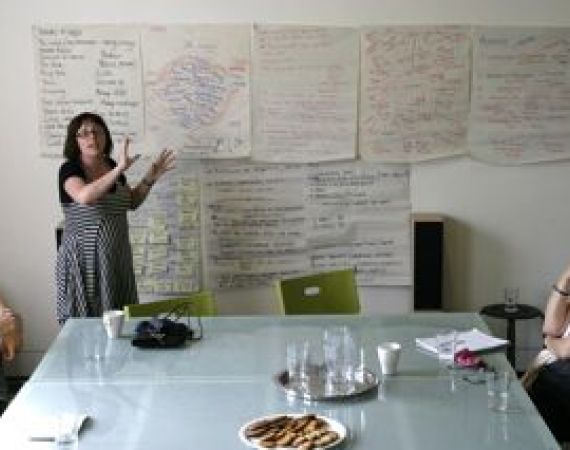Posted on Thu 5 May 2011
Work-in-Progress event - Wednesday 20 April, 2011
The second discussion event with the studio's South West artist residents took place on Wednesday 20 April. We welcomed an audience to the studio to catch up on the progress of the two project groups. Here is a round up of the two presentations and the following discussions. The Stick House Having…

The Stick House
The second discussion event with the studio's South West artist residents took place on Wednesday 20 April. We welcomed an audience to the studio to catch up on the progress of the two project groups. Here is a round up of the two presentations and the following discussions.
The Stick House
Having been paired for this project with little knowledge of one another, the first weeks of Tom Burton and Sharon Clark's residency were dedicated to fusing their disparate working methods. This has paid off as they are making breakthroughs together, rather than apart. Despite Tom's structured approach striking fear in Sharon's heart, the 'gears have meshed together early on'. Here are some key points from their presentation:
This is a piece for traditional theatre audiences, not for gamers. It will draw on theatre conventions and use technology invisibly. The audience must have agency, but not feel that 'getting it wrong' is a possibility.The audience will have five roles within the piece: they will watch, influence the narrative, journey, interact with the characters and collaborate with the performers. An early decision was made to use a plant, who guides the experience and gradually becomes a character within the narrative.
By the end of the residency, the pair want to write the first ten minutes of the play, and build three prototypes.
You can follow the project's development here: http://www.pmstudio.co.uk/project/the-stick-house-artists-residencies-2011
The Guerilla Dance Project
Unlike Sharon and Tom, Robin Ray, Laura Kriefman and Tim Bamber have collaborated before. This project is the natural next-step in a line of exciting pervasive work. This residency has provided a safe space to find out how technology can further embed their pervasive dance and music into the fabric of everyday life. Following their introductory talk, setting up initial experiments and prototyping have been the priority. From guerilla dance and hidden backing tracks in the Watershed bar, to implanting speakers in coffee cups - the process has begun.
The piece will run in a cyclical fashion: the dancers dance with smart object, the objects make music, the dancers dance to the music - but how can Tim maintain agency over the composition whilst such unpredictable factors take precedence? How can the group make sure the piece also sounds good, and not just messy?
A set of repeated phrases could mean the dance teaches the dancers to play the objects like instruments. The dance will draw on traditional social dances, easy to pick up and join in with. The group want to engage audiences, but need to decide how much interactivity is appropriate. The piece will have multiple outcomes and functions. It will be a game for the participants, and a composition and performance piece for people in the public space.
If the piece is prefaced as a 'game' you must invite people formally, this will differ greatly to previous Guerilla Dance Project work which appeared and disappeared without warning. The group are about to begin playing with accelerometers, gyroscopes, iphones, RjDj, FeONIC speakers, arduino and bespoke solutions.
Follow the project here: http://www.pmstudio.co.uk/project/guerilla-dance-project